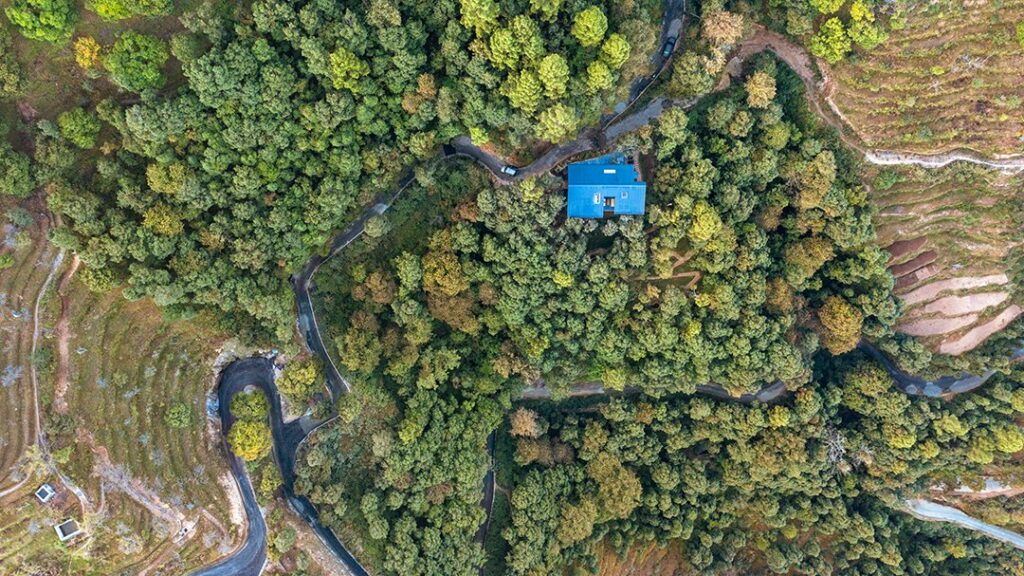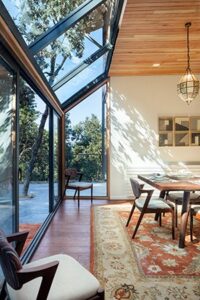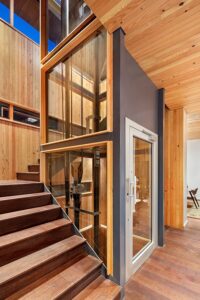Nestled between Bhimtal and Mukteshwar in the serene landscapes of Uttarakhand, the Villa in the Woods stands as a testament to conscious community living amidst the breathtaking Himalayan forests. This architectural marvel, crafted by Studio Lotus, part of a thoughtful masterplan, seamlessly integrates into its natural surroundings at 6,700 ft above sea level.
Located between Bhimtal and Mukteshwar in the northern Indian state of Uttarakhand, the Villa in the Woods is part of a masterplan designed to promote conscious community living amidst 90 acres of Himayalan forests of deodar, sal, oak, and rhododendron. With direct access from India’s capital New Delhi, it lies in the Kumaon range of the Himalayas at an altitude of 6,700 ft.
The brief for the masterplan development was centred around building a self-sufficient community in the hills, living in harmony with nature. The design scheme factors in detailed analyses of the existing terrain, slopes, vegetation, surface drainage patterns, and soil types. These studies were done to identify strategies for watershed management, stormwater management, and potential areas for development to minimise cut-and-fill and avoid disturbing the site’s ecology.
With construction in the hills in India rapidly rising and damaging the sensitive terrain, the architects adhered to an eco-conscious sensibility. The architecture adopts pre-engineered technology with a structure composed of Light Gauge Framing Systems (LGSF) clad with locally sourced materials. Mandating off-site construction, the architects leveraged a custom-designed modular system that uses lightweight mild steel sections and a six-layered drywall section, allowing the three-storey structures to be assembled at site from a kit of numbered pre-engineered parts. The construction uses a woven structural system akin to a basket weave, where structural integrity is derived from the composite whole as opposed to the strength of individual members. A narrative of age-old crafts skills developed with local artisans is superimposed on the primary shell.
Concrete piles and tie beams anchor the superstructure, whereas the dry construction methodology allows for a smooth and clinical construction process with nearly zero waste generation. Therefore, the villa prevents damage to the slopes and surrounding trees.

Universal Access
The villa offers wheelchair accessibility and can be serviced by elevators. Wide boardwalks lead to the homes from access points, and all homes are directly accessible from the road.
Response to Terrain
Land parcels were demarcated according to gradient, sun exposure, scenery, and tree locations. The construction methodology adopted lends flexibility to bend the structures according to the site contours. The villa is raised on stilts to allow the flow of natural water streams. Brush layering, a bio-engineering method, was used to stabilise the slopes further, while stone-built gully plugs allowed rainwater to percolate into the ground.
Building Lightly
The modular construction system employs minimal on-site wet work to cause the least disturbance to the site and surrounding ecology. It supports the efficient use of resources and energy with reduced water consumption and preserves the natural flow of water along
the gradient.
The plan for the villa follows the blueprint of nature, with each element sensitively charted out in congruence with the landscape. A dominant theme throughout is one of fluid transitions, removing the boundaries, and living with nature. Nestled amidst the dense foliage of deodar, chide, and oak trees, the villa is perched on stilts. Designed to evoke the experience of treehouse living, the elevated structure is capped by a pitched roof and spacious balconies, offering residents solitude and direct connections with the
lush outdoors.


The villa is split into three levels to offer differentiated experiences and uninterrupted lines of sight. Residents enter via a wooden boardwalk into the living quarters which also comprise a kitchen and dining area. A north-facing deck and a south-facing court promote outdoor lounging with panoramic vistas of the forests beyond. The floor above hosts bedrooms featuring floor-to-ceiling bay windows and skylights that frame expansive views of the landscape and fill interior spaces with daylight. The lowermost level houses the guest bedroom, staff quarters and ancillary facilities, merging with the gradient of the slope under canopy of native vegetation. The dining area doubles up as a conservatory, which, in addition to the sliding doors, window walls, and skylights, illuminates the interiors with daylight and enables residents to stargaze at night. The sun-drenched south court is strategically located to establish a seamless inside-outside experience and maximise views of the natural setting. The material palette of timber, slate, and local stone builds on the lexicon of koti-banal architecture, endemic to the Kumaon region. The interior design scheme further underpins the experience of being cocooned in a treehouse through its use of hand-crafted woodwork that blends classic notions of a simple wood structure with modernist angles, clean lines, and contemporary design elements.
Sustainability and energy efficiency being paramount design concerns in an ecologically sensitive context, the Villa in the Woods utilises a range of measures to reduce its environmental impact.


The integration of the native landscape, seasonal water bodies, and large tree cover ensures comfortable ambient temperatures for most of the year. The structure occupies a small footprint to minimise the impact on the existing terrain and trees. The wastewater is treated through a phytorid-based system and is reused for horticulture among other purposes.
Through the incorporation of passive solar design and the use of vernacular building materials, the design simultaneously addresses aspects of daylight, natural ventilation, thermal comfort, and energy use.
The building orientation and fenestration design ensure effective daylighting in all occupied spaces, reducing energy consumption to a minimum. Interior surfaces including the walls, floors, and the roof feature adequate insulation layers to regulate temperature and prevent heat loss during winters. Further, a radiant heating system is provided to optimise thermal comfort and
energy use.
Fact File
Project: The Villa in the Woods, Uttarakhand
Architect: Studio Lotus
Structural Consultant: Manjunath & Co.
PMC: Build Kraft India
Fabricator: Creative Craft
Status: Completed





